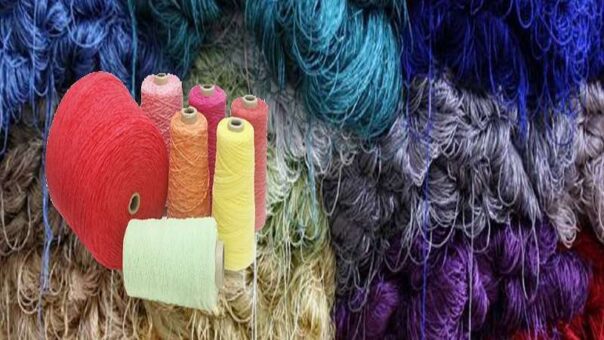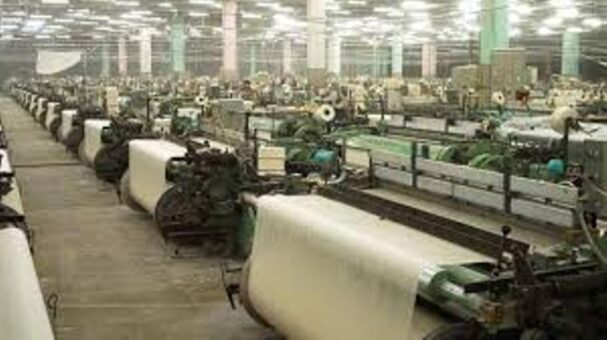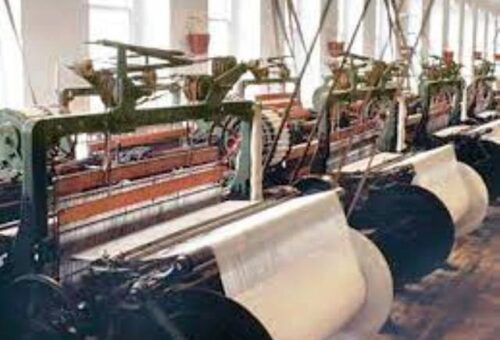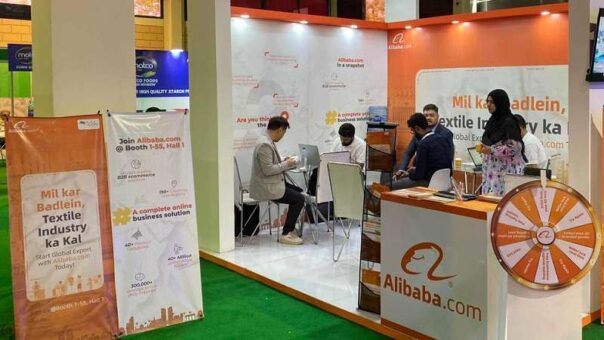Karachi, May 26, 2023 – Alibaba.com, a leading global business-to-business (B2B) e-commerce platform, Friday announced its participation in the 4th International Textile Exhibition (TEXPO 2023), organized by the Trade Development Authority of Pakistan (TDAP) from May 26 to May 28, 2023.
(more…)Tag: Textile export
-

Pakistan textile exports slump by 14% amid global recession
Pakistan’s textile exports have experienced a significant slump of around 14 percent in the period of July to April 2022-2023, according to data reported by the Pakistan Bureau of Statistics (PBS).
(more…) -

Pakistan’s textile group exports decline by 12.4% in first nine months of 2022-23
Pakistan’s textile group exports have declined by 12.4% in the first nine months of the current fiscal year 2022-23, amounting to $12.476 billion as compared to $14.242 billion during the same period last year, according to data released by the Pakistan Bureau of Statistics (PBS).
(more…) -

Pakistan textile exports plunge by 30% in February 2023
KARACHI: Textile exports of Pakistan have plunged by 30 per cent in February 2023 owing to challenging economic scenario of the country.
(more…) -

Pakistan textile exports decline by 11pc amid global economic slowdown
KARACHI: Pakistan textile exports registered a decline of over 11 per cent Month on Month (MoM) basis in October 2022 to $1.36 billion due to global economic slowdown.
“This is the lowest number since May 2021,” said Shameer Alam Zaidi, analyst at Ismail Iqbal Securities. He said the effect of global economic slowdown and high inventory levels held with retailers is now becoming more visible.
READ MORE: Industries threaten mass protest against gas supply shutdown
The fall in export value has mainly come from volumetric decline as prices of almost all categories have either increased or stayed flat. This has taken fiscal year to date exports into negative territory with 1.4 per cent decline in first four months (July – October) of fiscal year 2022-2023.
Among value added items, bedwear has witnessed the largest decline of 19 per cent (on MoM basis), down to $217 million. Knitwear has remained on the downward path in October 2022 and declined by 10 per cent to $392 million. Among non value added items, cotton yarn has shown the largest decline of 35 per cent.
READ MORE: Pakistan organizes first international housing expo next month
The textile machinery imports have maintained a downward trend and are down by 21 per cent MoM to $42 million as against last 12 month average of $57 million. Raw cotton import is up 9 per cent on MoM basis, where the quantity is up 15 per cent. The cumulative import of raw cotton in first four months of the current fiscal year is up by 4.7 per cent, however the quantity imported is down by 11 per cent, which shows that the industry has not yet covered for the shortage of local cotton crop due to floods.
The realized price of imported cotton has been recorded at $2.8 per kilogram as against 2.4/kg and 3/kg in October 2021 and September 2022, respectively.
READ MORE: APTMA urges PM to save textile industry from total closure
The analyst said that the textile exports are expected to remain under pressure due to lack of new orders amid global economic slowdown and high inventory levels held by US retailers.
On domestic front, amid winter season the gas supply to textile industry has decreased as consumers are government’s first priority. “This has forced the industry to switch towards grid which is likely to hurt Sindh based exporters as the province enjoys significant lower gas rates compared to Punjab,” he added.
READ MORE: Reducing foreign currency cash carrying limits to half criticized
-

Pakistan textile exports hit 11-month low in July 2022
KARACHI: Pakistan textile exports hit 11-month low in July 2022 to $1.48 billion, down 13 per cent month on month (MoM).
Analysts at Topline Securities on Tuesday said that tis was mainly due to decline witnessed in value-added segment down by 12 per cent MoM, mainly due to (i) Eid holidays during the first half of July, (ii) Lack of energy supplies, and (iii) global economic slowdown.
READ MORE: Pakistan’s textile exports hit record high at $19.33 bn in FY22
In Pakistani Rupee (PKR) terms, the same has clocked in at Rs325 billion, down by 7 per cent MoM.
During the month, the Government of Pakistan closed down the gas supplies to both export and non-export industry in Punjab till July 9, 2022. The decision was made to divert more LNG to the power sector for more electricity generation to mitigate power outages.
READ MORE: Textile exports surge to record high $11 billion in 7MFY22
Under Value-added division, Ready-made segment remained major underperformer as exports witnessed 17 per cent MoM decline to $305 million during July 2022 due to sharp decline in volumetric sales down by 7 per cent MoM.
Other value-added players such as Knitwear, Bedwear and Towel also posted decline of 8 per cent MoM, 11 per cent MoM, and 18 per cent MoM to $435 million, $254 million and $75 million, respectively.
READ MORE: PHMA cries foul on gas suspension to textile industry
Basic textiles also witnessed decline of 14 per cent MoM to $258 million in July 2022 (down 5 per cent YoY), where major decline came from cotton yarn where exports touched $71 million (down 24 per cent MoM).
As compared with July 2021, Pakistan textile exports marginally up by 1 per cent YoY (+38 per cent YoY in PKR terms) in July 2022 due to growth in value added segment.
Moving forward, increase in energy tariff and slowdown in global economy are few key challenges textile sector could face going ahead.
READ MORE: Textile exporters urge allowing cotton import from India
-

Pakistan’s textile exports hit record high at $19.33 bn in FY22
ISLAMABAD: Pakistan has exported textile products worth $19.33 billion during the fiscal year 2021/2022 making a record high on annual basis.
The country exported textile products worth $19.33 billion during fiscal year 2021/2022, showing an increase of 25.53 per cent when compared with $15.4 billion in the preceding fiscal year, according to data released by Pakistan Bureau of Statistics (PBS) on Tuesday.
READ MORE: Textile exports surge to record high $11 billion in 7MFY22
The textile exports contributed around 61 per cent to the total exports of $31.8 billion during the fiscal year 2021/2022.
Textile sector plays a significant role in supporting the economy of Pakistan and continue to be in the spotlight owing to country’s dependence on foreign exchange.
According to analysts at Insight Research, the Pakistani Rupee (PKR) devaluation against the US dollar gave textile exporters a competitive advantage over its competitors in terms of pricing.
READ MORE: PHMA cries foul on gas suspension to textile industry
In terms of value, the export of knitwear recorded an increase of 34.23 per cent to $5.12 billion during the fiscal year 2021/2022 as compared with $3.81 billion in the preceding fiscal year.
The export of readymade garments exhibited an increase of 28.75 per cent to $3.9 billion during fiscal year 2021/2022 when compared with $3.03 billion in the preceding fiscal year.
Similarly, the export of bed wear recorded an increase of 18.8 per cent to $3.29 billion in the fiscal year 2021/2022 as compared with $2.77 billion in the preceding fiscal year.
READ MORE: Textile exporters urge allowing cotton import from India
Meanwhile, foreign buyers purchased Pakistani cotton cloths worth $2.44 billion during the fiscal year under review as compared with $1.92 billion in the preceding fiscal year, showing an increase of 27 per cent.
The analysts said that some factors are posing threat to the textile industry for the current fiscal year such as i.e., increase in export refinance rate.
Moreover, cotton shortage remains the key concern for the country as the demand for textile industry grows but cotton production has declined substantially over the last decade, mainly due to fall in cultivation area followed by lower yield resulting from water shortage and inconsistent rainfall.
In the fiscal year 2021/2022, cotton production stood at 8.3 million bales, which is 2.2 million bales lower than the targeted production.
However, production has increased by 1.3 million bales compared to last year.
“Thus, due to the supply and demand gap, textile industry has to rely on imported cotton to meet the country’s demand, putting pressure on country’s import bill,” the analysts added.
READ MORE: Value added textile exporters demand 50 percent reduction in withholding tax
The government was eyeing to fetch textile exports of $25 billion for the fiscal year 2022-2023. However, domestic and global challenges are dampening the outlook.
Possible increase in gas and electricity tariff amid the ongoing energy crises could hamper the local demand. In addition, global economic slowdown due to surging inflation will result in lower apparel demand.
Moreover, in case of surge in covid-19 cases and imposition of lockdown, textile industry’s operating rate would get effected negatively. Having these challenges in mind, the analysts believe that it would be tough to achieve such growth in textile exports.
-

Textile exports surge to record high $11 billion in 7MFY22
KARACHI: The exports of textile products have witnessed sharp increase of 25 per cent to $11 billion during first seven months (July – January) 2021/2022 7MFY22, according to data of the Pakistan Bureau of Statistics (PBS) released on Wednesday.
The exports of textile products were $8.76 billion in the same months of the last fiscal year.
READ MORE: SBP expands export finance scheme to improve inflows
In Pak Rupee (PKR) terms, the same has clocked in at Rs1,861 billion, up 30 per cent YoY due to 4 per cent currency devaluation, analysts at Topline Securities said.
During 7MFY22, key export driver was increase in value-added exports where knitwear segment contributed the most as it increased by 33 per cent YoY to $2.9 billion followed by Ready-made garments (+22 per cent YoY to $2.2 billion) and Bedwear (+19 per cent YoY to $1.9 billion) exports, respectively.
On MoM basis, Pakistan textile exports is down 4 per cent to $1.5 billion in Jan-2022, led by lower value-added exports segments mainly in Knitwear (down 12 per cent MoM) and Ready-made garments (down 4 per cent MoM) respectively.
READ MORE: PHMA cries foul on gas suspension to textile industry
Compared to last year, Pakistan textile exports are up by 17 per cent YoY (29 per cent YoY up in PKR terms) in Jan-22 led by significant recovery witnessed in value-added segments, largely in knitwear (up 19 per cent YoY), Ready-made (up 17 per cent YoY) and Bedwear (up 21 per cent YoY).
Increased volumetric growth and improved pricing were the key drivers resulting in higher exports.
Going forward, the analysts expect textile exports to keep robust in ongoing FY22 fiscal year to clock in at $18.5-19 billion.
Ease of lockdown in European economies is likely to drive increased orders and help overall textile exports, the analysts added.
The Federal Cabinet on February 15, 2022 has finally approved the Textile and Apparel Policy 2020-25, after Ministry of Commerce (MoC) submitted the revised draft of textile policy to Economic Coordination Committee (ECC) incorporating few amendments.
READ MORE: Textile exporters urge allowing cotton import from India
The key reason behind the late approval was the dispute between MoC and Energy Ministry on the issue of Energy Tariffs (RLNG and Electricity).
As per reports, the updated draft stated that Energy Tariffs (RLNG and Electricity) will be provided to textiles and apparel industry at regionally competitive rates during the policy years. For this, tariff will be reviewed and announced in federal budget by Finance Division.
As per Pakistan Institute of Development Economics (PIDE), the average regional electricity tariff rate stood at 7.4 cents/kWh in Mar-21, which we believe has likely increased since than. Pakistan’s current electricity tariff is around 9 cents/Kwh.
READ MORE: Gas shortage created purposely for using RLNG: KCCI
In case of RLNG, the average regional RLNG rate stood at $4/MMBTU as per PIDE as compared with Pakistan’s tariff rate at $6.5/MMBTU. The analysts believe the above stated textile policy will have a neutral impact on the sector. Given, Pakistan is already offering subsidized energy & RLNG tariffs to textile players and Pakistan being part of an IMF program, a further reduction from the current levels is highly unlikely.
RLNG tariff is expected to remain intact at $6.5/MMBTU level although regional average is comparatively low. To note, RLNG is currently being provided at $9/MMBTU to textile sector till March-22 due to supply issues.
-

Pakistan’s textile exports jump to record high at $9.4bn
KARACHI: Pakistan’s textile exports recorded all time high to $9.4 billion during first half (July – December) of 2021/2022.
As per the data reported by Pakistan Bureau of Statistics (PBS) on Tuesday, Pakistan textile exports witnessed a record first half (July-December) exports of $9.4 billion in 2021/2022, up by 26 per cent YoY.
READ MORE: Textile exporters urge allowing cotton import from India
In Pak Rupee (PKR terms), the same has clocked in at Rs1,587 billion, up 30 per cent YoY (more than $ terms due to 4 per cent currency devaluation as compared to 1HFY21), analysts at Topline Securities said.
During the first half of the current fiscal year, major export driver was significant increase in value-added exports where knitwear segment contributed the most as it increased by 35 per cent YoY to $2.5 billion followed by Ready-made garments (+23 per cent YoY to $1.8 billion) and Bedwear (+19 per cent YoY to $1.7 billion) exports, respectively.
READ MORE: Value added textile exporters demand 50 percent reduction in withholding tax
On MoM basis, Pakistan textile exports clocked in at $1.6 billion (down by 6 per cent) in Dec 2021, mainly driven by low volumetric sales in all segments excluding raw cotton on account of recent hike in Omicron cases world wide specially in Europe & USA.
READ MORE: Gul Ahmed Textile declares 4-time increase in net profit during nine months
Compared to last year, Pakistan textile exports are up by 16 per cent YoY (28 per cent YoY up in PKR terms) in Dec-21 led by significant recovery witnessed in value-added segments, largely in knitwear (+29 per cent YoY) and Ready-made (+22 per cent YoY). Low base, increased volumetric growth in Knitwear and improved pricing led to higher exports.
The analysts expect textile exports to remain robust in ongoing fiscal year (FY22) and expect it to clock in at $18-18.5 billion. Though, slowdown in European economies and lockdowns due to Omicron remain key risk for the sector.
READ MORE: Value-added textile demands allowing cotton yarn import from India
-

Pakistan exports textile products worth $11.35bn in nine months
KARACHI: Pakistan has exported textile products worth $11.35 billion during first nine months (July – March) 2020/2021, showing 9 percent growth, according to data released by Pakistan Bureau of Statistics (PBS) on Saturday.
The exports of textile products during the first nine months of the last fiscal year were at $10.41 billion, the PBS reported.
In terms of volume the export of knitwear was on the top in textile exports. The country exported knitwear products worth $2.78 billion during first nine months of the current fiscal year as compared with $2.29 billion in the corresponding months of the last fiscal year, showing a growth of 21 percent.
The export of readymade garments was recorded at $2.27 billion during July – March 2020/2021 as compared with $2.17 billion in the corresponding period of the last fiscal year.
The export of bedwear recorded 16.5 percent growth to $2.05 billion during first nine months of the current fiscal year as compared with $1.76 billion in the corresponding period of the last fiscal year.
The export of textile products in the month of March 2021 recorded 30 percent growth to $1.35 billion when compared with $1.04 billion in the same month of the last year.
